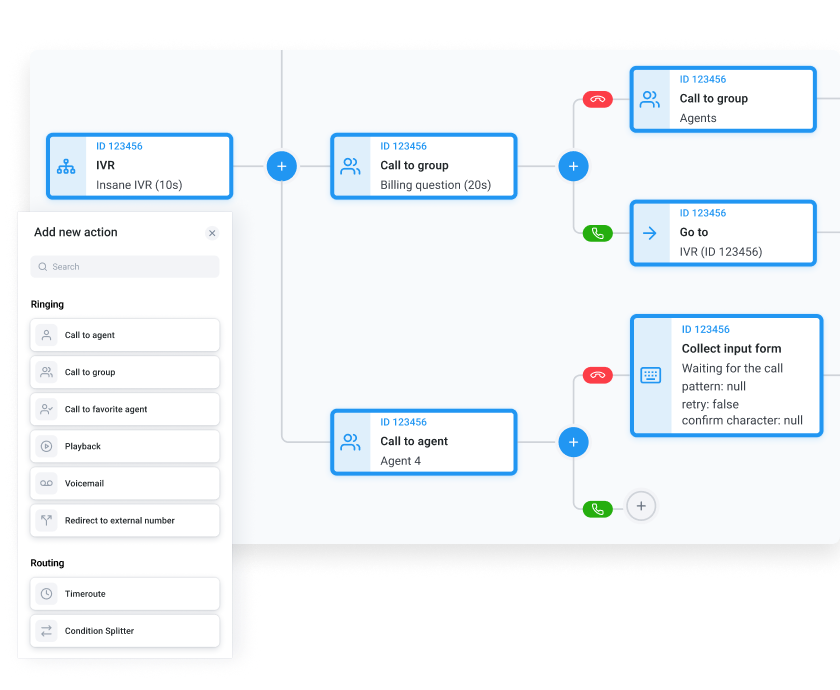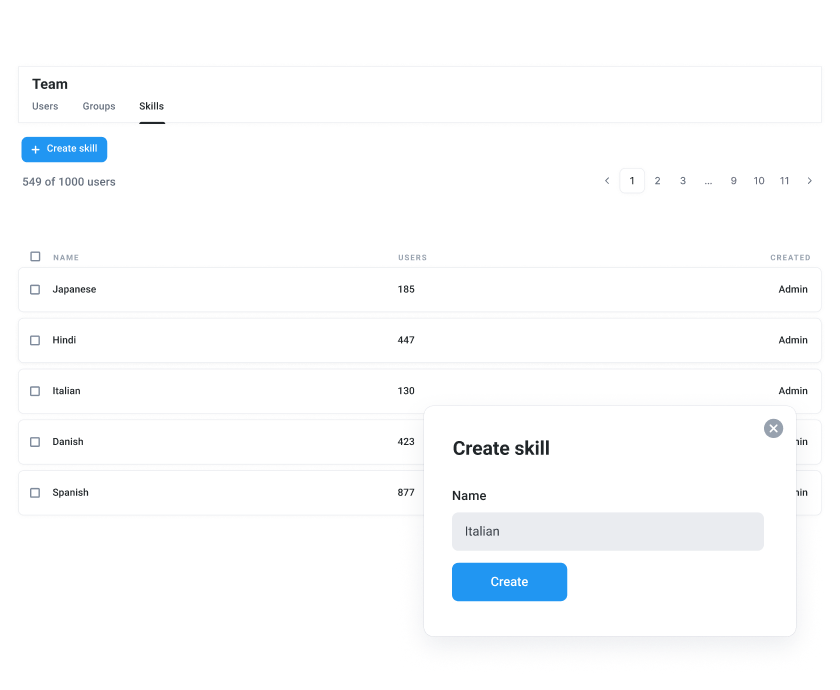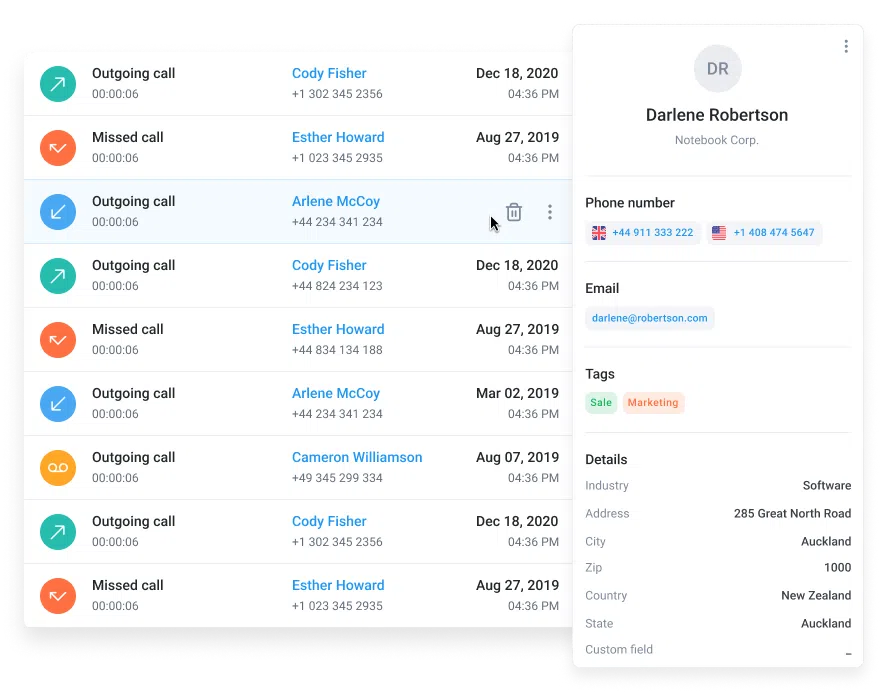Conversational IVR: Definition, Key Benefits & Implementation
It’s 8 PM, your office is closed, and a prospect calls to book a demo. Normally, that lead’s gone—lost to voicemail or a “call back later” message. But with conversational IVR, they can schedule it instantly—no agent needed.
Conversational IVR acts like an always-on team member—handling routine tasks, booking appointments, and even surfacing upsell opportunities while your team focuses elsewhere.
In fact, according to Gartner, conversational AI could cut contact center labor costs by $80 billion by 2026.
Use this article to understand how conversational IVR works, what it delivers, and how to use it to increase customer satisfaction and revenue.
Key takeaways:
- AI-powered conversational IVR improves the customer experience, leading to higher CSAT scores and greater brand loyalty.
- Conversational IVR boosts FCR by intelligently routing calls to the best agent or automating simple issues without human involvement.
- CloudTalk’s conversational IVR reduces wait times and simplifies interactions, improving efficiency and customer satisfaction.
Transform your customer support
What Is Conversational IVR?
We’ve all been there—pressing “1” for sales, “2” for support, and “0” hoping to reach a human. Traditional IVR systems can feel rigid and impersonal, slowing down the experience instead of improving it.
Conversational IVR changes the game by letting callers simply say what they need, just like they would with a real person.
Instead of rigid menus, conversational IVR uses AI technologies like machine learning, natural language processing (NLP), and natural language understanding (NLU) to understand customer intent in real-time.
Whether a caller wants to check an order status or schedule a demo, the system listens, responds, and guides them where they need to go.
If a transfer to a live agent is necessary, they can access the caller’s history, so your customer never has to repeat themselves.
Who Benefits from Conversational IVR?
Conversational IVR is a game-changer for businesses aiming to improve customer experiences and streamline operations. Here’s who stands to benefit the most:
- Sales and marketing teams take advantage of IVR’s ability to automate demo bookings and lead qualification, so no opportunities are missed.
- Customer support teams leverage IVR to handle routine inquiries so agents can focus on complex issues and improve first-contact resolution.
- Businesses with high call volumes use IVR to provide 24/7 coverage and faster routing, minimizing wait times.
- Cost-conscious enterprises find IVR helpful in reducing labor costs, freeing up resources for higher-value tasks like upselling and customer engagement.
In short, any business looking to boost satisfaction, enhance efficiency, and cut costs will benefit from conversational IVR.
Differences between conversational IVR and traditional IVR
No one enjoys battling a robotic phone menu. Traditional IVR systems work well for basic call routing but can feel limited when customers have more complex or open-ended requests.
On the other hand, conversational IVR delivers fast, personalized experiences, and improves with every interaction. It’s like upgrading to a smart assistant who actually gets what your customers are asking for.
Here’s how conversational IVR systems stack up against traditional IVR:
Aspect
Traditional IVR
Conversational IVR
Interaction Style
Menu-driven, structured with sub-menus
Natural language, conversation-like interaction
User Experience
Simple, familiar but sometimes limited
Intuitive, engaging, and more human-like
Input Methods
Optimizes call management.
Optimizes customer experience.
Flexibility
Limited to predefined call flows and menus
Handles a wide range of requests and open dialogue
IVR Speech Recognition
Basic IVR voice recognition of commands such as “yes” or “billing”
Understands full sentences with natural language
Response Generation
Pre-recorded prompts and fixed responses
Dynamic responses tailored to user input
Support Hours
24/7 self-service
24/7 self-service with human-like interactions
Topic Complexity
Handles low to mid-level issues
Manages both simple and complex queries with AI technology
Automation Level
Some tools require complex programming, others use visual call flows
No-code automation for easier updates
Personalization
Limited to CRM-based caller data
Deep personalization using real-time user data
Customer Satisfaction
Reduces call wait times when optimized
Boosts satisfaction with natural, responsive interactions
Want to understand your customers better?
Benefits of conversational IVR
According to a study by McKinsey & Company, improving IVR containment rates—the percentage of calls fully handled by an IVR system—can slash call center costs by as much as 30%.
Conversational IVR goes further by enabling natural, AI-driven interactions that handle requests without rigid menus or repetitive prompts. Let’s take a closer look.
Reduced Wait Times and Faster Resolutions
Gone are the days of long hold times. With smart IVR, customers can resolve routine issues instantly, without waiting for an agent.
By using CloudTalk in conjunction with an IVR system, you can make sure your best customers never have to wait. Use CloudTalk to create VIP Queues and let your favorite customers skip the line.
Improved Call Routing and Self-Service Options
IVR can automate tasks that don’t necessarily require human input, freeing up your phone lines and leading to faster resolutions.

With self-service options powered by conversational IVR, customers can:
- Check order status
- Book appointments
- Update their account details
CloudTalk’s intelligent routing makes sure that every customer is directed to the right place, whether it’s self-service or a live agent. This helps keep things efficient and ensures your team can focus on higher-priority tasks.
Higher Customer Satisfaction and Engagement
A positive customer experience goes a long way, and IVR interactions feel more personal and natural. Customers can speak in full sentences, making the conversation flow smoothly and more engaging.
Whether they need a quick answer or a more complex solution, CloudTalk’s AI-powered features, like Sentiment Analysis and Talk-Listen Ratio, create a harmonious experience that boosts customer satisfaction and keeps them coming back.
CloudTalk’s Caller-Based Routing phone system uses real-time customer data and caller history to make smart decisions on where to direct incoming calls so customers reach the right agent the first time.
Increased Efficiency for Support Teams
Manual call reviews and note-taking can eat up valuable time. Call intelligence automates these tedious tasks, providing instant transcriptions and insights.
This means agents can focus on conversations rather than paperwork, saving them time that they can direct towards improving customer interactions.
Key Metrics You Can Improve With Conversational IVR
Sophia, a support manager at a fast-growing e-commerce brand, was overwhelmed by rising call volumes and frustrated customers. Long wait times and repeat calls affected performance metrics.
After implementing CloudTalk’s conversational IVR, she transformed her team’s operations. Smarter call flows and automated self-service resolved common issues instantly, routed complex queries efficiently, and provided real-time insights.
The outcome: Faster resolutions, fewer follow-ups, and happier customers.
Let’s dive into the key metrics Sophia improved along with real-life success stories from CloudTalk customers who’ve seen these benefits firsthand.
Average Handle Time (AHT)
Conversational IVR enhances call handling by automating routine queries and directing complex issues to the appropriate agent.
Take Talent.io, for example. By using CloudTalk’s advanced call routing and automated workflows, Talent.io reduced manual tasks for agents, improving customer response times. With fewer repetitive tasks, agents could focus on resolving more complex issues, directly improving AHT.
CloudTalk’s Call Flow Designer and Speech-to-Text Transcriptions streamline interactions and make handle times easy to track. By analyzing call patterns and refining IVR flows, you can keep calls short while still delivering top-notch service.

First Call Resolution (FCR) Rate
A high First Call Resolution (FCR) rate leads to fewer follow-ups and more satisfied callers. Conversational IVR boosts FCR by intelligently routing calls to the best agent or automating simple issues without human intervention.
With CloudTalk’s real-time Analytics and intelligent call routing, Nokia optimized its customer support team of 200 agents.
By identifying workflow gaps, such as increasing ring time before calls were marked as missed, they reduced missed calls and improved FCR.
CloudTalk Analytics also helped Nokia better manage missed calls, improving productivity by 10%.

Call Containment and Automation Success
Call containment measures how many calls your system resolves without human intervention. Conversational IVR increases containment by handling diverse queries through Natural Language Processing (NLP) and smart automation.
DiscoverCars automated over 70% of their customer inquiries using CloudTalk’s advanced IVR. This reduced the volume of agent-handled calls, cutting operational costs while maintaining customer support quality.
Customer Satisfaction Score (CSAT)
When customers get quick answers and avoid long hold times, satisfaction naturally increases.By implementing CloudTalk’s Smart IVR and Call Tagging, companies like Alura offer a smooth, frustration-free experience. Personalized call flows and 24/7 self-service options ensure customers always find help when they need it, boosting CSAT.
CloudTalk’s AI conversation intelligence drastically improved our efficiency. We’ve cut call quality analysis time from 2 hours to 20 minutes a day and reduced wrongly targeted leads by 24%, enabling us to focus on strategic growth while maintaining consistency across markets.
Sara Konickova, Sales Ops Manager at Capitalo
Implementation Steps for Conversational IVR
So you’ve decided to integrate conversational IVR into your business—now what? In this section, we’ll walk you through the implementation process so you can effectively deploy the technology.
1. Define Use Cases and Customer Needs
Start by identifying the most common customer queries that can be automated. What issues can conversational IVR resolve on its own, and when should it pass the call to an agent?
Consider your industry’s specific needs—what works for finance might be different from what’s needed in retail or tech. The clearer you are on your use cases, the easier it will be to design flows that actually reduce confusion rather than just shift it.
2. Design Conversational Flows and Routing
Your aim is to create smooth and intuitive conversation flows. A call flow is the journey a customer takes from the moment they dial your number right up until their issue has been resolved.
This journey can include multiple components that work together to create a seamless experience for the caller. This includes:
- Automated greetings
- Menu options through interactive voice response (IVR) systems
- Customized routing strategies
- Hold music or messages
- Voicemail options
- Agent transfers
Focus on creating paths that feel natural, minimizing any friction for the customer. At the same time, implement clear routing logic to ensure customers are directed to the right place—whether that’s resolving their issue through IVR or handing them off to a live agent when needed.

To design your ideal call flow, document your existing call-handling process. Identify:
- Common customer inquiries
- How calls are routed
- Where delays occur
Gather call logs, agent feedback, and customer surveys to understand where bottlenecks exist.
Then, use CloudTalk’s Call Flow Designer to rebuild your customer journey—visually, without writing a single line of code. It lets you test and adjust routing logic on the fly so you’re not locked into static paths.
Next, tap into CloudTalk’s Analytics to review historical data. Spot patterns like high call abandonment during peak hours or specific call types that clog up agent time. These insights help you allocate resources more effectively and reduce friction in high-traffic areas.
Finally, use Call Monitoring and Call Tagging to categorize live calls and track trends in real-time. This gives you an ongoing view into how your flows are performing—and where to optimize next.
3. Integrate With CRM and Support Systems
Integrating conversational IVR with your CRM and support systems gives agents the context they need to provide faster, more personalized service. When a customer interacts with IVR, their information—like past purchases, support history, and inquiry details—is logged and instantly available if the call is taken by a live agent.

To get started, map out the systems your IVR should connect with, including customer databases, help desks, and marketing platforms.
If you’re using CloudTalk, integrations are easy. With native CRM integrations like HubSpot, Salesforce, and Pipedrive, you can sync call logs, notes, and customer histories automatically. Help desk integrations with platforms like Zendesk and Freshdesk let your team access support tickets and caller data instantly.
4. Test, Optimize, and Continuously Improve
Regular testing and optimization keep your system accurate, efficient, and aligned with customer expectations.
Start by running test calls to evaluate the system’s accuracy in recognizing speech and correctly routing inquiries.
Try testing the system from different perspectives: A new customer seeking product information, an existing customer needing technical support, and a caller trying to reach the billing department.
Each scenario reveals how smoothly your IVR handles different requests. Ask these questions as you run through the testing process:
- Is it answering questions accurately?
- Are customers quickly routed to the right agent when needed?
- Are they getting stuck in loops?
Look out for common issues like misrouted calls, unclear prompts, or frequent transfers to live agents. Use customer feedback, agent insights, and call analytics to identify areas for improvement.
Boost CSAT Scores with Conversational IVR
Sophia’s team saw measurable improvements after switching to conversational IVR—faster resolutions, fewer repeat calls, and a noticeable lift in CSAT. Her story isn’t unique. With the right setup, these results are achievable for any support team facing similar challenges.
Conversational IVR transforms how you handle calls. It delivers fast, personalized experiences at scale—no extra headcount or technical overhead required.
You’ll cut wait times, lower abandonment rates, and give every caller a smoother path to resolution.
With CloudTalk, AI-powered routing, automation, and self-service tools work together to keep your support team efficient and your customers satisfied—24/7.
Exceed customer expectations
Sources
Conversational IVR FAQs
How Does Conversational IVR Improve Customer Experience?
It reduces wait times, offers 24/7 self-service, and routes calls accurately. Learn how CloudTalk’s IVR boosts customer satisfaction.
What Types of Businesses Benefit the Most From Conversational IVR?
Industries with high call volumes—like e-commerce, finance, and healthcare—gain the most from CloudTalk’s automated IVR solutions.
Does Conversational IVR Require Advanced AI Training?
It automates simple tasks and routes complex issues to the right agent using CloudTalk’s smart call routing features.
What Are the Key Signs That a Business Should Upgrade to Conversational IVR?
If your team faces long hold times, repetitive queries, or missed calls, IVR can streamline operations and improve service.























